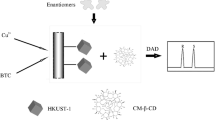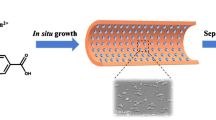Abstract
An in situ zeolite imidazole metal organic framework-90 (ZIF-90) modified capillary was prepared via the method of solvothermal synthesis. The coating of ZIF-90 was characterized by scanning electron microscopy, energy-dispersive X-ray spectrometry, and EOF. Capillary electrochromatography–based enantioseparation of the basic drugs propranolol (PRO), metoprolol (MET), atenolol (ATE), bisoprolol (BIS), and sotalol (SOT) was performed using lactobionic acid (LA) as the chiral selector. Compared with an uncoated silica capillary, the resolutions are greatly improved (PRO 1.40 → 3.23; MET 1.07 → 3.19; ATE 1.07 → 3.15; BIS 1.16 → 3.41; SOT 1.00 → 2.79). Effects of buffer pH values, proportion of organic additives, concentration of lactobionic acid, and applied voltage were investigated.

Schematic presentation of the preparation of zeolitic imidazolate framework-90 (ZIF-90) modified capillary (ZIF-90@capillary) for enantioseparation of drug enantiomers. The capillary was applied to construct capillary electrochromatography system with lactobionic acid for enantioseparation of basic chiral drugs.





Similar content being viewed by others
References
Gusev I, Huang X, Horváth C (1999) Capillary columns with in situ formed porous monolithic packing for micro HPLC and capillary electrochromatography. J Chromatogr A 1855(1):273–290. https://doi.org/10.1016/S0021-9673(99)00697-4
D'Orazio G, Asensio-Ramos M, Fanali C, Hernández-Borgesb J, Fanalia S (2016) Capillary electrochromatography in food analysis. Trends Anal Chem 82:250–267. https://doi.org/10.1016/j.trac.2016.06.012
Xu L, Pi C, Wang D, Tang C, Dong L, Zhang C (2014) Preparation and characterization of lysine-immobilized poly (glycidyl methacrylate) nanoparticle-coated capillary for the separation of amino acids by open tubular capillary electrochromatography. J Chromatogr A 1323:179–183. https://doi.org/10.1016/j.chroma.2013.10.093
Bao T, Tang P, Kong D, Mao Z, Chen Z (2016) Polydopamine-supported immobilization of covalent-organic framework-5 in capillary as stationary phase for electrochromatographic separation. J Chromatogr A:S0021967316304010. https://doi.org/10.1016/j.chroma.2016.03.085
Zhao H, Wang Y, Zhang D, Cheng H, Wang Y (2017) Electrochromatographic performance of graphene and graphene oxide modified silica particles packed capillary columns. Electrophoresis 39(7):933–940. https://doi.org/10.1002/elps.201700435
Sun J, Yang S, Cheng H, Wang Y, Liu J (2019) Multi-particle frits for packed capillary columns in electrochromatographic use. J Chromatogr A 1595:221–229. https://doi.org/10.1016/j.chroma.2019.02.046
Tran L, Shuchi D, Jung H (2015) Enantioseparation of basic chiral drugs on a carbamoylated erythromycin-zirconia hybrid monolith using capillary electrochromatography. J Chromatogr A 1356:289–293. https://doi.org/10.1016/j.chroma.2014.06.089
Park JM, Park JM (2014) Enantiomer separations of basic chiral compounds by capillary electrochromatography on a phosphated β-cyclodextrin-modified zirconia monolith. J Chromatogr A 1339:229–233. https://doi.org/10.1016/j.chroma.2014.03.008
Fei Z, Zhang M, Zhang J, Yuan L (2014) Chiral metal–organic framework used as stationary phases for capillary electrochromatography. Anal Chim Acta 830:49–55. https://doi.org/10.1016/j.aca.2014.04.054
Guihen E, Glennon JD (2004) Recent highlights in stationary phase design for open-tubular capillary electrochromatography. J Chromatogr A 1044:67–81. https://doi.org/10.1016/j.chroma.2004.05.107
Liu Z, Otsuka K, Terabe S (2002) Evaluation of extended light path capillary and etched capillary for use in open tubular capillary electrochromatography. J Chromatogr A 961:285–291. https://doi.org/10.1016/S0021-9673(02)00662-3
Zhang Q, Du Y, Du S (2014) Evaluation of ionic liquids-coated carbon nanotubes modified chiral separation system with chondroitin sulfate E as chiral selector in capillary electrophoresis. J Chromatogr A 1339:185–191. https://doi.org/10.1016/j.chroma.2014.02.003
Sun X, Chen C, Li X, Du Y, Zhao S, Feng Z (2020) Gold nanoparticles coated with a tetramethylammonium lactobionate ionic liquid for enhanced chiral differentiation in open tubular capillary electrochromatography: application to enantioseparation of β-blockers. Microchim Acta 187(3):170. https://doi.org/10.1007/s00604-020-4121-2
Okamoto Y, Ikawa Y, Kitagawa F, Otsuka K (2007) Preparation of fritless capillary using avidin immobilized magnetic particles for electrochromatographic chiral separation. J Chromatogr A 1143(1–2):264–269. https://doi.org/10.1016/j.chroma.2007.01.006
Gong Z, Duan L, Tang A (2015) Amino-functionalized silica nanoparticles for improved enantiomeric separation in capillary electrophoresis using carboxymethyl-β-cyclodextrin (CM-β-CD) as a chiral selector. Microchim Acta 182:1297–1304. https://doi.org/10.1007/s00604-015-1449-0
Sun X, Du Y, Zhao S, Huang Z, Feng Z (2019) Enantioseparation of propranolol, amlodipine and metoprolol by electrochromatography using an open tubular capillary modified with β-cyclodextrin and poly (glycidyl methacrylate) nanoparticles. Microchim Acta 186(2):128. https://doi.org/10.1007/s00604-018-3163-1
Li L, Yang F, Wang H, Yan X (2013) Metal-organic framework poly methylmethacrylate composites for open-tubular capillary electrochromatography. J Chromatogr A 1316:97–103. https://doi.org/10.1016/j.chroma.2013.09.081
Hayashi H, Cote A, Furukawa H, O'Keeffe M, Yaghi O (2007) Zeolite A imidazolate frameworks. Nat Mater 6(7):501–506. https://doi.org/10.1038/nmat1927
Cheong L, Wei Y, Wang H, Wang Z, Su X, Shen C (2017) Facile fabrication of a stable and recyclable lipase@amine-functionalized ZIF-8 nanoparticles for esters hydrolysis and transesterification. J Nanopart Res 19(8):280. https://doi.org/10.1007/s11051-017-3979-3
Huang A, Liu Q, Wang N, Zhu Y, Caro J (2014) Bicontinuous zeolitic imidazolate framework ZIF-8@GO membrane with enhanced hydrogen selectivity. J Am Chem Soc 136(42):14686–14689. https://doi.org/10.1021/ja5083602
Chen B, Yang Z, Zhu Y, Xia Y (2014) Zeolitic imidazolate framework materials: recent progress in synthesis and applications. J Mater Chem A 2(40):16811–16831. https://doi.org/10.1039/C4TA02984D
Ding W, Yu T, Du Y, Sun X, Feng Z, Zhao S, Ma X, Ma M, Chen C (2019) A metal organic framework-functionalized monolithic column for enantioseparation of six basic chiral drugs by capillary electrochromatography. Microchim Acta 187(1). https://doi.org/10.1007/s00604-019-3998-0
Carrasco-Correa E, Martínez-Vilata A, Herrero-Martínez J, Parra J, Maya F, Cerdà V, Cabello C, Palomino G, Svec F (2017) Incorporation of zeolitic imidazolate framework (ZIF-8)-derived nanoporous carbons in methacrylate polymeric monoliths for capillary electrochromatography. Talanta 164:348–354. https://doi.org/10.1016/j.talanta.2016.11.027
Li Y, Bao T, Chen Z (2016) Polydopamine-assisted immobilization of zeolitic imidazolate framework-8 for open-tubular capillary electrochromatography. J Sep Sci 40(4):954–961. https://doi.org/10.1002/jssc.201601152
Huang A, Dou W, Caro J (2010) Steam-stable zeolitic imidazolate framework ZIF-90 membrane with hydrogen selectivity through covalent functionalization. J Am Chem Soc 132(44):15562–15564. https://doi.org/10.1021/ja108774v
Yu L, Yan X (2013) Covalent bonding of zeolitic imidazolate framework-90 to functionalized silica fibers for solid-phase microextraction. Chem Commun 49(21):2142–2144. https://doi.org/10.1039/C3CC00123G
Yu L, Yang C, Yan X (2014) Room temperature fabrication of post-modified zeolitic imidazolate framework-90 as stationary phase for open-tubular capillary electrochromatography. J Chromatogr A 1343:188–194. https://doi.org/10.1016/j.chroma.2014.04.003
Zhu M, Zhang L, Chu Z, Wang S, Chen K, Zhang W, Liu F (2018) Preparation and evaluation of open-tubular capillary columns modified with metal-organic framework incorporated polymeric porous layer for liquid chromatography. Talanta 184:29–34. https://doi.org/10.1016/j.talanta.2018.02.010
Wang X, Hu X, Shao Y, Peng L, Zhang Q, Zhou T, Xiang Y, Ye N (2019) Ambient temperature fabrication of a covalent organic framework from 1,3,5-triformylphloroglucinol and 1,4-phenylenediamine as a coating for use in open-tubular capillary electrochromatography of drugs and amino acids. Microchim Acta 186:650. https://doi.org/10.1007/s00604-019-3741-x
Pan C, Wang W, Zhang H, Xu L, Chen X (2015) In situ synthesis of homochiral metal–organic framework in capillary column for capillary electrochromatography enantioseparation. J Chromatogr A 1388:207–216. https://doi.org/10.1016/j.chroma.2015.02.034
Ye N, Wang X, Liu Q, Hu X (2018) Covalent bonding of Schiff base network-1 as a stationary phase for capillary electrochromatography. Anal Chim Acta 1028:113–120. https://doi.org/10.1016/j.aca.2018.04.037
Acknowledgements
This work was supported by the Project of National Natural Science Foundation of China (No.: 82073809).
Author information
Authors and Affiliations
Corresponding author
Ethics declarations
Conflict of interest
The authors have declared no conflict of interest.
Additional information
Publisher’s note
Springer Nature remains neutral with regard to jurisdictional claims in published maps and institutional affiliations.
Supplementary Information
ESM 1
(DOCX 1.06 mb)
Rights and permissions
About this article
Cite this article
Ding, W., Ma, M., Du, Y. et al. Metal organic framework ZIF-90 modified with lactobionic acid for use in improved open tubular capillary electrochromatographic enantioseparation of five basic drugs. Microchim Acta 187, 651 (2020). https://doi.org/10.1007/s00604-020-04611-1
Received:
Accepted:
Published:
DOI: https://doi.org/10.1007/s00604-020-04611-1




